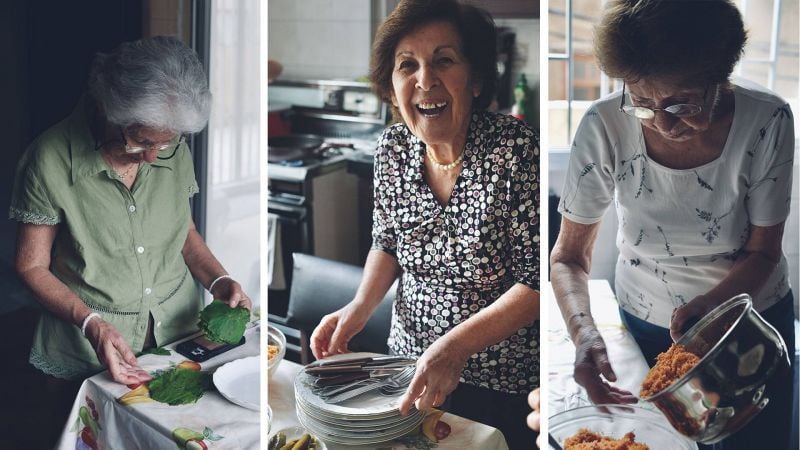
Armenian grandmothers Jeni, Mary and Anouk Bzdigian in Bourj Hammoud, Beirut, 10 May, 2024 (Photo: Olivia Le Poidevin/L'Orient Today)
Fried fish, spring rolls, vegetable stews. As I stand in the melée of a Sunday market in Hamra, behind Cairo street, a riot of flavours and smells assault the senses. Here members of the Filipino, Bengali, Syrian and Ethiopian community come to sell their wares.
This small square, packed to the brim with food, clothes and soaps, is a small microcosm of Beirut's larger, diverse and ever evolving migrant community.
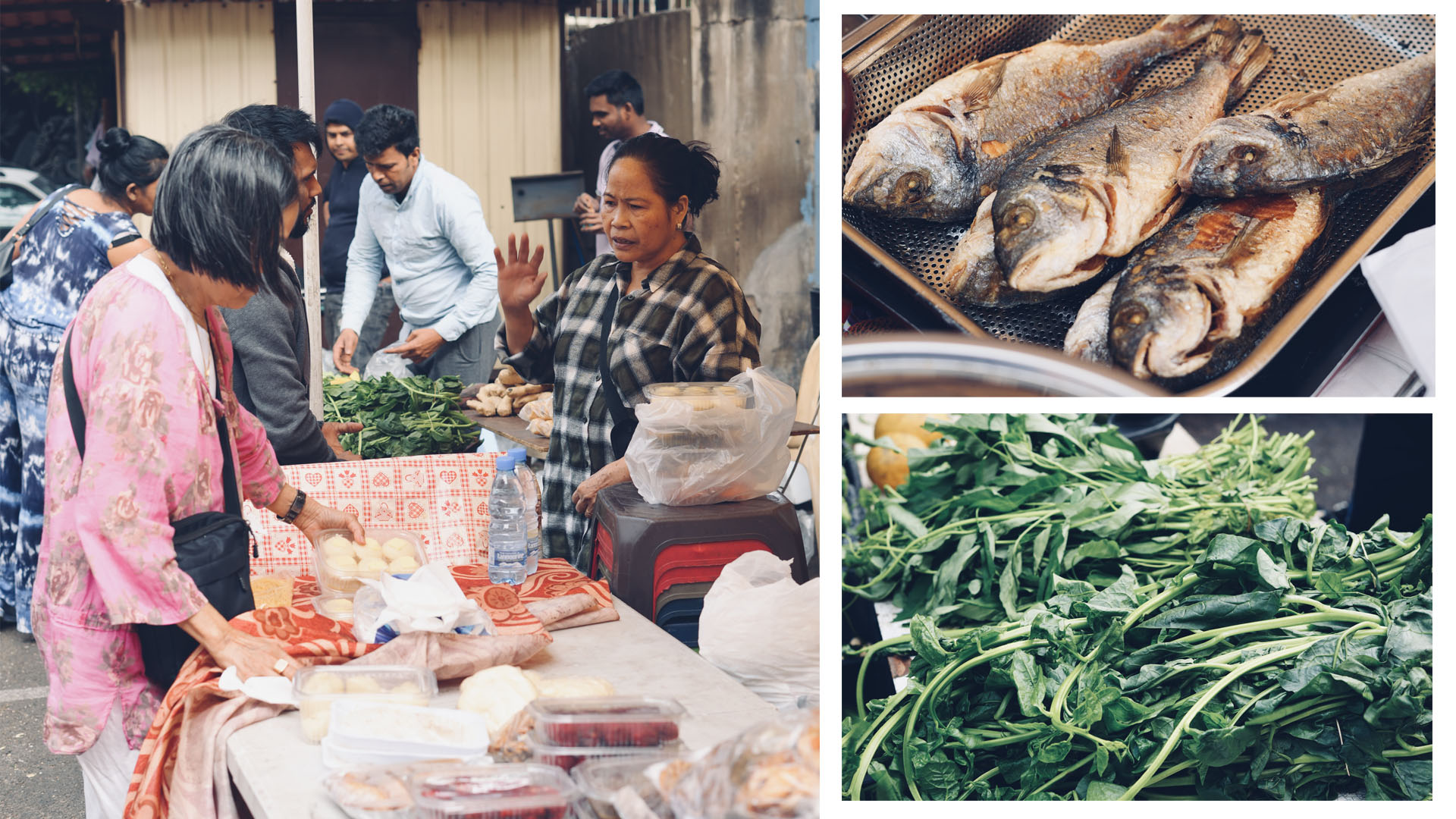 People selling food at a Sunday market in Hamra, Beirut, May 5, 2024 (Photo: Olivia Le Poidevin/L'Orient Today)
People selling food at a Sunday market in Hamra, Beirut, May 5, 2024 (Photo: Olivia Le Poidevin/L'Orient Today)
In the last century Lebanon has seen numerous waves of migration — refugees fleeing war and migrants searching for work. In the 1920s, around the same time Lebanon was declared a state, Armenian refugees, fleeing the genocide of 1915-1924 that killed more than a million people, arrived in the country of the cedars. In 1948, the Nakba drove tens of thousands of Palestinians northwards to Lebanon.
In the same decade, Syrians start arriving for work, a trend that continued into the 60s. In the 1970s, workers from Sri Lanka, India, Vietnam, the Philippines and Ethiopia came in search of better opportunities, while Lebanon became the home of wealthy investors from the Gulf seeking to store their money in Beirut’s banks.
By the early 2000s there was an influx of Iraqi refugees fleeing the US-led military invasion, followed by Syrians in 2011, escaping a bloody civil war. To this day, domestic workers from an ever widening range of nationalities make the journey to work in Lebanon, bringing with them their own food stories and culture. From Hamra to Dawra, Bourj Hammoud to Burj el Barajneh, we trace how migration has dynamized Lebanon’s food scene, encouraging our palettes to embrace new flavors in an ever widening path of culinary diversity.
Early 20th Century: Armenians
By 1925, 50,000 Armenians fleeing genocide sought refuge in Lebanon. Many settled in camps in Bourj Hammoud. With them they brought their food culture — a story of displacement and confluence of culinary influences from their long and complex history with Turkey.
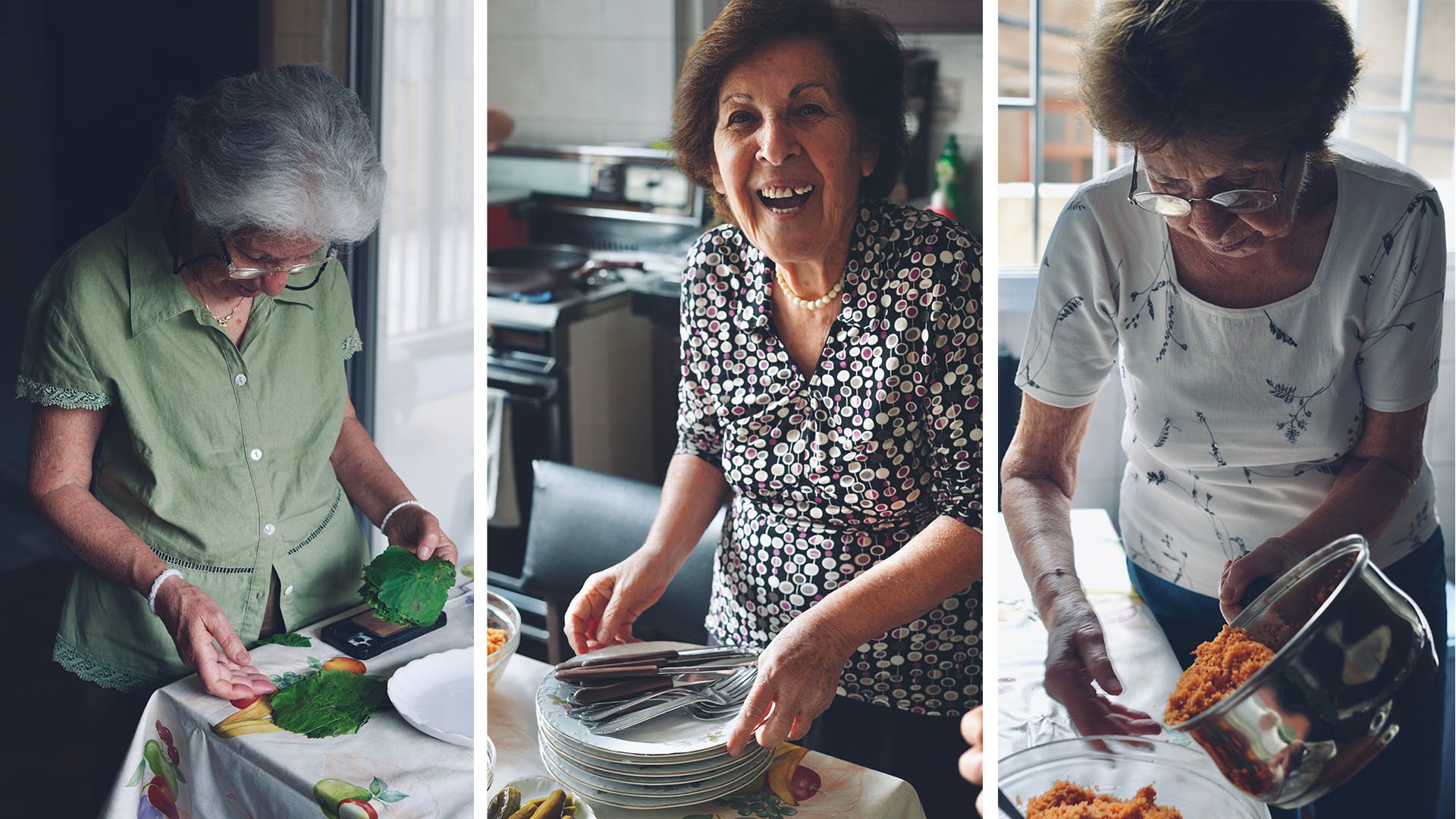 Armenian grandmothers Jeni, Mary and Anouk Bzdigian in Bourj Hammoud, Beirut, 10 May, 2024 (Photo: Olivia Le Poidevin/L'Orient Today)
Armenian grandmothers Jeni, Mary and Anouk Bzdigian in Bourj Hammoud, Beirut, 10 May, 2024 (Photo: Olivia Le Poidevin/L'Orient Today)
The first migrant restaurants that opened in Lebanon in the 20th century are said to have been Armenian. Over the last sixty years, they have become ubiquitous. The famous Ghazar bakery opened in the 1960s, Onno in the 1970s and Varouj in 1994. Mayrig arrived in 2003. Seza, Mayrig, Batchig, Badguer are other notable mentions.
"My grandmother came here in the 1920s. They brought with them all their knowledge of Armenian cooking, which we learnt from our grandmother and my mother," says Mary Bzdigian, one of three second generation Armenian Lebanese sisters affectionately known in the community as the "Armenian grandmothers." We met inside their cozy apartment in Bourj Hammoud, where black and white photos of the family decorated walls and shelfs, and hand-embroidered cloths adorned the tables.
"I don’t like to eat out," declares Jeni Bzdigian. "I prefer to cook at home." This soon makes perfect sense when your eyes gaze over at the kitchen table amassed with mounds of stuffed artichokes, vine leaves and pickles. The grandmothers add the final touches to the lunch we’re about to eat, conversing with each other in a mix of western Armenian and Lebanese Arabic. This linguistic confluence is a mirror of the food they cook: a story of migration, exchange, loss and renaissance, all with a strong nod to the roots of the homeland.
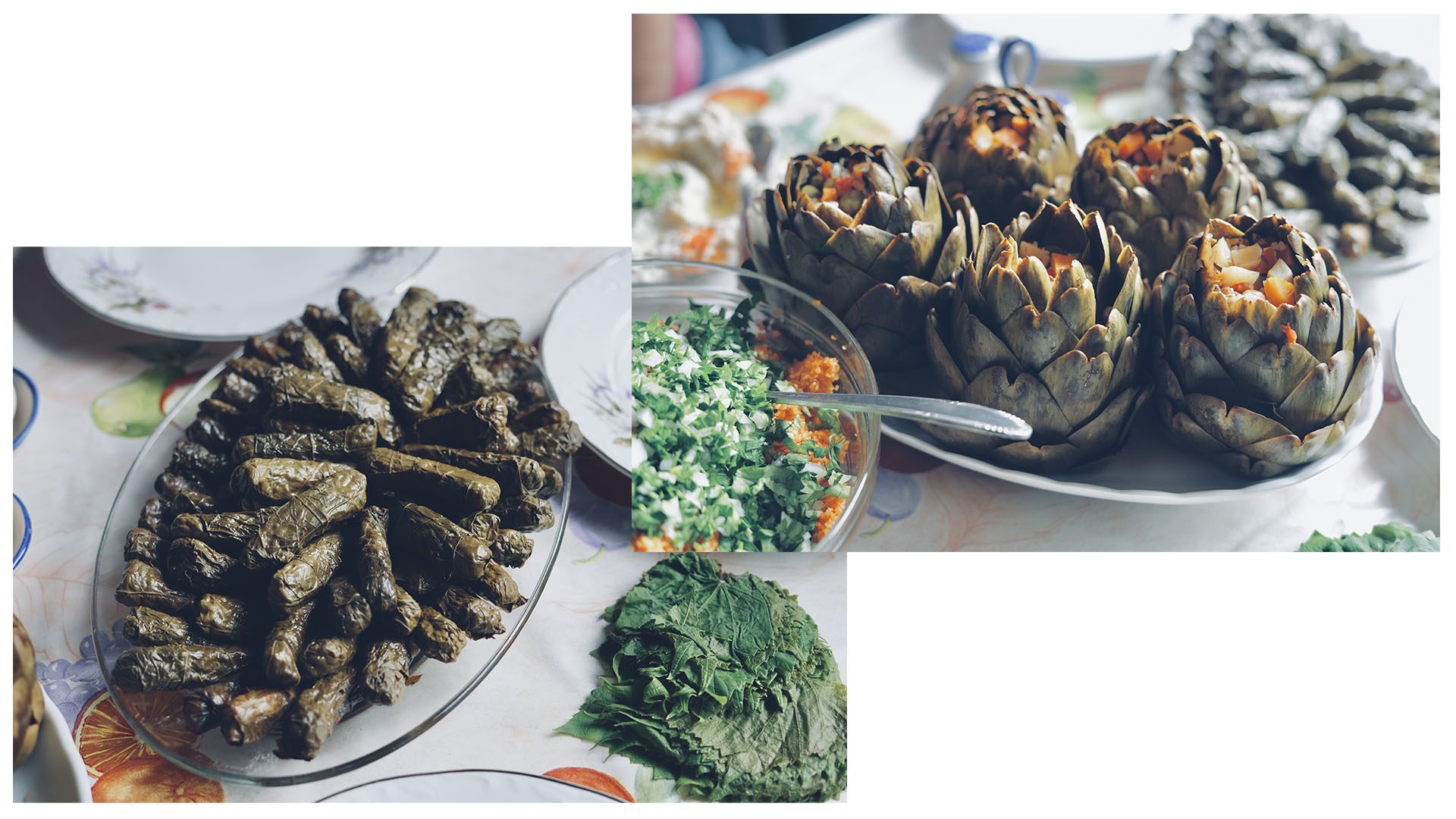 Armenian lunch table with stuffed vine leaves (left) and stuffed artichokes (right) in Bourj Hammoud, Beirut, 10 May, 2024 (Photo: Olivia Le Poidevin/L'Orient Today)
Armenian lunch table with stuffed vine leaves (left) and stuffed artichokes (right) in Bourj Hammoud, Beirut, 10 May, 2024 (Photo: Olivia Le Poidevin/L'Orient Today)
What is Armenian food ?
Before sitting down to eat with the grandmothers it is important to understand the basics of Armenian cuisine. "In Armenian cooking it’s all about meat, dough and the bakery," says Yervant, a third generation Lebanese-Armenian whose family arrived in Lebanon following the genocide. We met in a narrow street within Bourj-Hammoud, where the first Armenian refugees arrived in the 1920s and set up camp with metal sheets.
"We use a lot of butter and take our time to prepare dishes," he says. He cites Manti, a canoe-shaped dough stuffed with beef and topped with a tomato and yogurt-garlic sauce, with sumac, as an example.
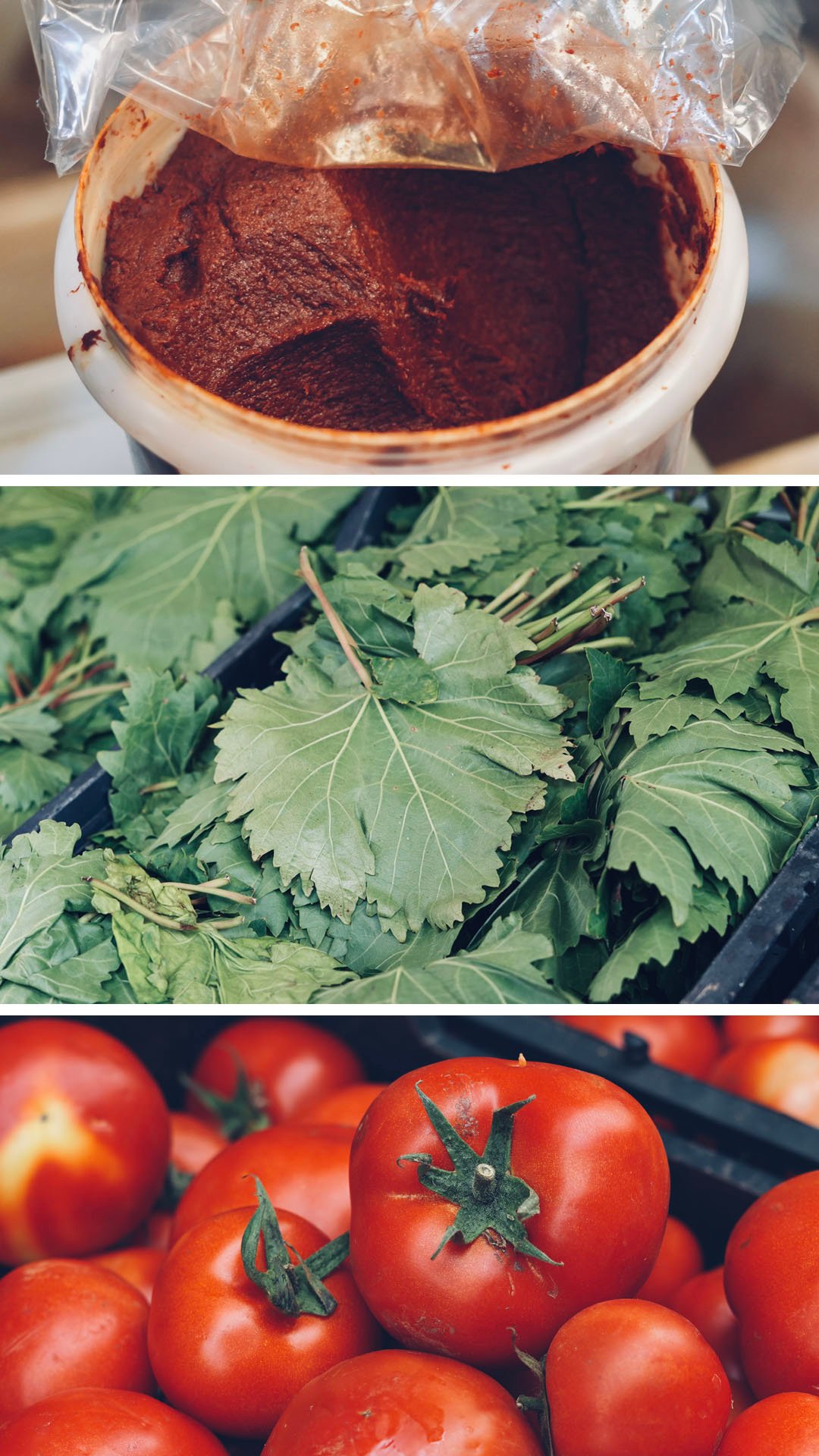 Collage of typical Armenian ingredients: pepper paste, vine leaves, and tomatoes being sold in Bourj Hammoud, Beirut, 10 May, 2024 (Photo: Olivia Le Poidevin/L'Orient Today)
Collage of typical Armenian ingredients: pepper paste, vine leaves, and tomatoes being sold in Bourj Hammoud, Beirut, 10 May, 2024 (Photo: Olivia Le Poidevin/L'Orient Today)
"Historically women would sit together and make Manti. It’s a sisterhood," describes Yervant. He believes this tradition reflects the close-knit Armenian culture that so many are proud to preserve. "We Armenians are diverse, we don't look Arab, we don't look Phoenician and we don't look European, we don't look Lebanese. We are always in between, half half." Yervant believes this ‘in-between’ identity has helped Armenians "blend well" into Lebanon. So much so that Armenia’s food traditions have become fully blended with Lebanon ones, with Armenian dishes like Manti and cherry sausages often found on Lebanese restaurant menus.
"In Armenia you don’t find Lebanese Armenian food. In Armenia the food is all about butter, a lot of fats, meats, soups and lots of bread. Their food is designed to fit their weather. You know, it's cold. In Lebanon the weather is warmer, so the dough is lighter, but you still find the traditional meat, cheese, tomato and pepper spice. But, unlike Lebanese food, Armenians like to add spice into their cooking."
"Also Armenians brought pumpkins to Lebanon," he adds. "We have the Kibbeh which is made of pumpkin."
Confluence and exchange in Lebanese-Armenian cuisine
Back in the grandmothers' kitchen, Jeni is spooning out an Armenian burghul-based salad known as Itch. "Oh it’s delicious," she exclaims. "We make it with lemon juice, cinnamon, black pepper, spring onions, tomato and pepper paste, and cumin," she lists.
"Armenian cooking, it's sacred" says Mary, beaming as she sprinkles the final sprouts of parsley on top of the ‘Itch’ which Jeni has handed her. "The Lebanese didn’t have Itch until the Armenians came," says Anouk proudly.
"If it’s spicy it will be more delicious. You eat it with grape leaves and cabbage," says Jeni. She points to the vine leaves growing in her garden.
Jeni serves a generous portion of ‘Itch’ onto my plate, reminding me that burghul is very good for you. Her mother lived until the age 92 and all three sisters, now seated at the table, are a picture of health. Mary offers me an Armenian ‘Sarma,’ a juicy vine leaf stuffed with rice and meat with lemon, similar to Lebanese Warak Enab.
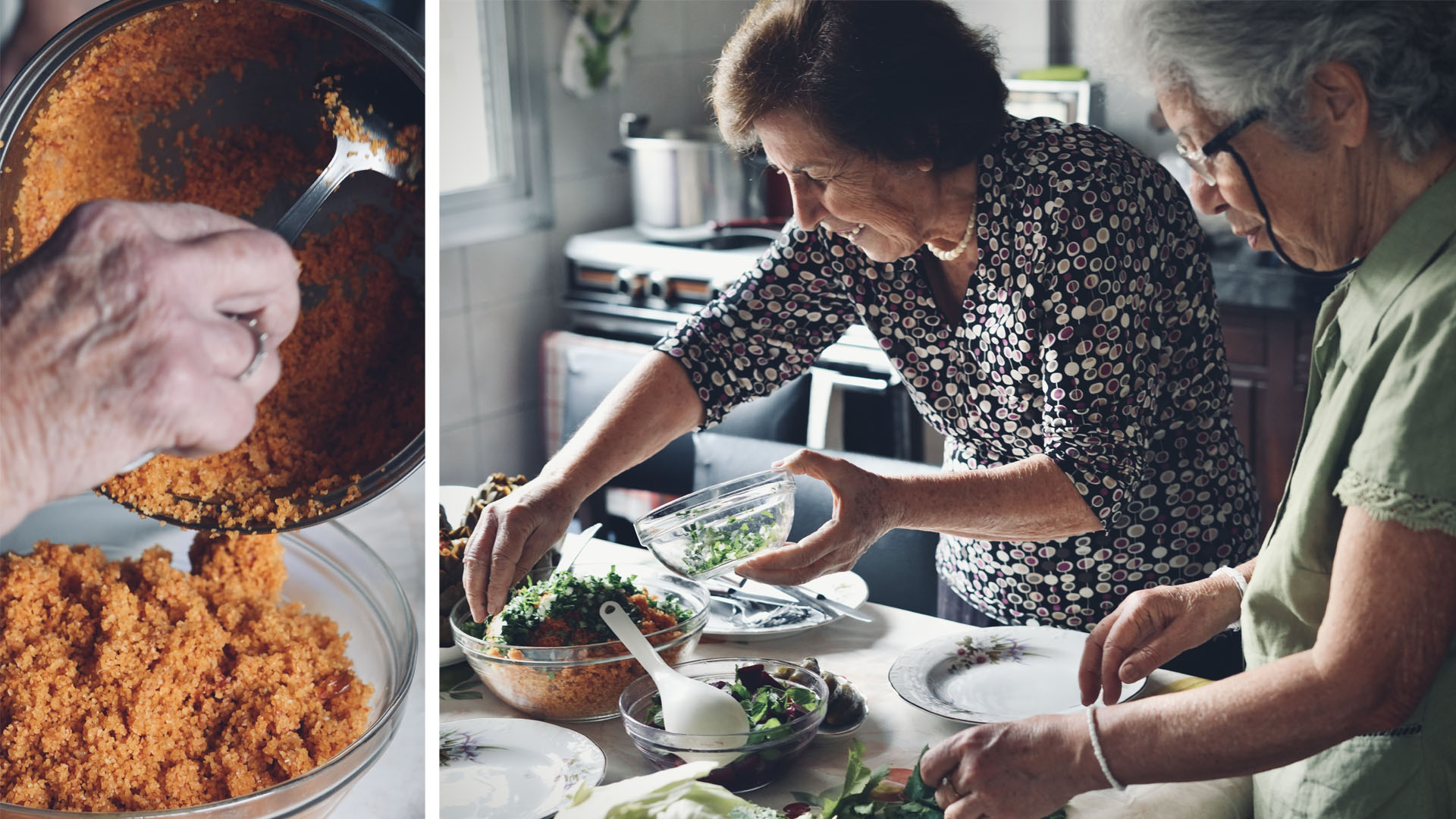 Collage of Armenian grandmothers Mary and Jeni Bzdigian serving Armenian 'Itch' at their apartment in Bourj Hammoud, Beirut, 10 May, 2024 (Photo: Olivia Le Poidevin/L'Orient Today)
Collage of Armenian grandmothers Mary and Jeni Bzdigian serving Armenian 'Itch' at their apartment in Bourj Hammoud, Beirut, 10 May, 2024 (Photo: Olivia Le Poidevin/L'Orient Today)
"For 600 years we lived peacefully with the Turks. We learned from some of their cuisine. And then in Lebanon we took some things, like ingredients, and then our neighbors here learned from us," says Mary.
Walking through the busy streets of Bourj Hammoud you can quite literally observe this merging of influences and flavors. Lebanese falafel on one side of the street, Aleppo peppers being sold at a Syrian-Armenian store on the other. Though distinctly different, there are many overlaps in Levantine and Armenian cuisine.
For example, the Armenians know Lebanon’s Sheik al Mahshi, which Azad Tashjian, the co-owner of Cafe Garo explains to me, as I peruse through shelves stuffed with dried fruits, nuts, pepper and tomato paste. Above me hang dried aubergines, dark and purpleish brown in color. She explains that they stuff them with tomato, pepper paste and meat.
"Bakery culture "
"Dough and bread is an important part of Armenian culture," says Yervant. "Everything is made in the bakery. As a child my mum used to give me tomato sauce with meat or eggplant and ask me to take it to the bakery. There they would put it on top of the bread, " he explained.
"The bakery is where the magic happens, there’s everything." He takes me into a bakery, piled with flat breads topped with chilli and the Armenian counterpart of Lebanese fatayer, stuffed with spinach and onions. "We have a traditional, spontaneous culture of food. Whatever you have in the house you make out of it. It’s a cuisine that is constantly evolving," says Yervant.
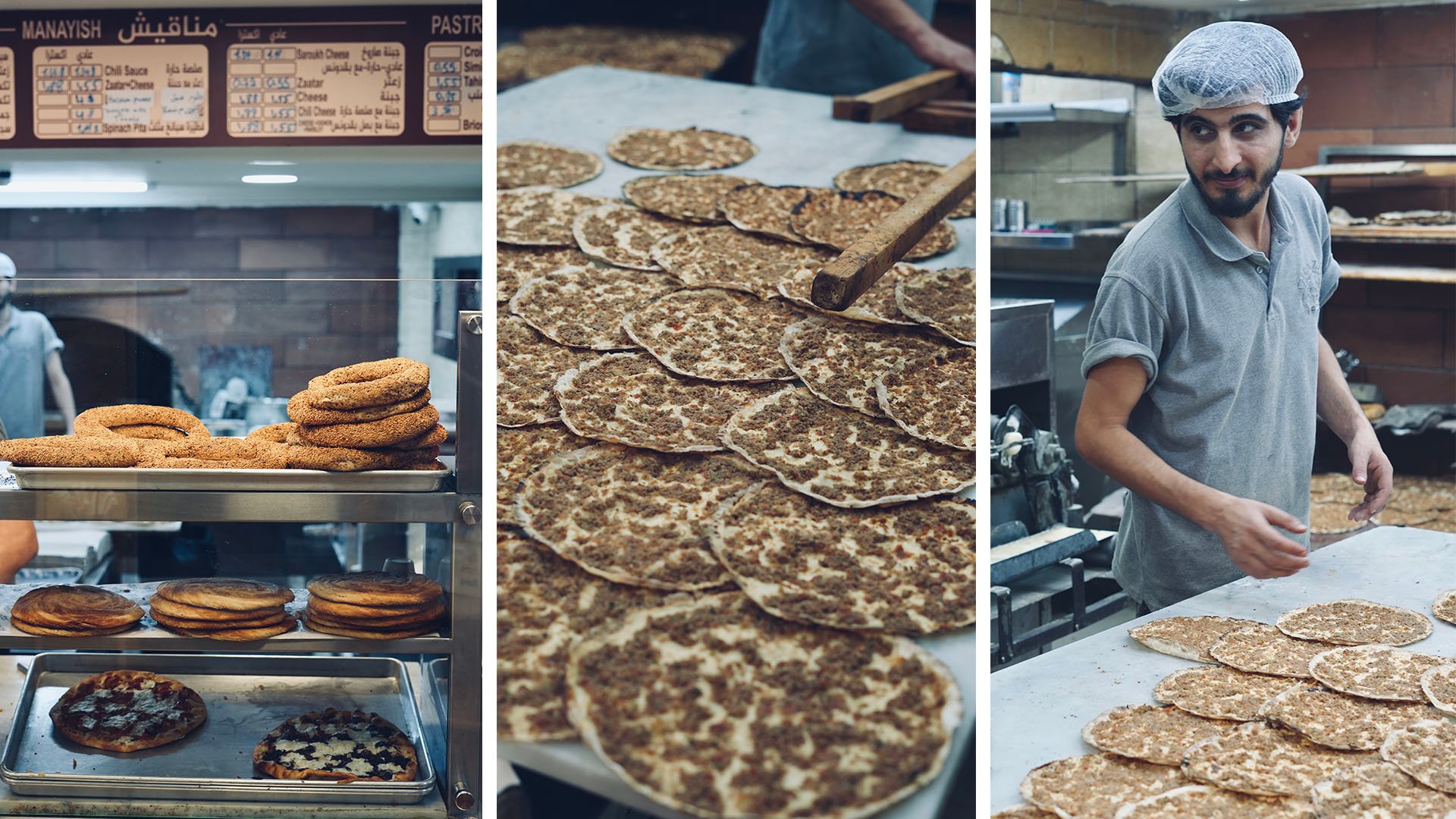 Armenian Lahmajoun at Ghazar Bakery in Bourj Hammoud, Beirut, 10 May, 2024 (Photo: Olivia Le Poidevin/L'Orient Today)
Armenian Lahmajoun at Ghazar Bakery in Bourj Hammoud, Beirut, 10 May, 2024 (Photo: Olivia Le Poidevin/L'Orient Today)
As we walk a few metrs from one bakery, we come across another. Through a half open window, I see young bakers preparing hundreds of Lahmajoun at Ghazar, which was been a local favorite since the 60s. Similar to the Lebanese version, this ‘Armenian pizza’ is covered with a cooked, spiced mix of ground meat, onions, parsley, tomatoes and green bell peppers. "But what's special about the Armenian one is that its dough is very thin and extremely delicate," says Yervant.
And it’s also in the bakery that you find ‘Tahinoz Hatz," a sweet, flaky tahini pastry with cinnamon. It pairs perfectly with the strong Armenian coffee served to me from a small street cart where dozens of Armenian men are taking a break in the midst of their work day.
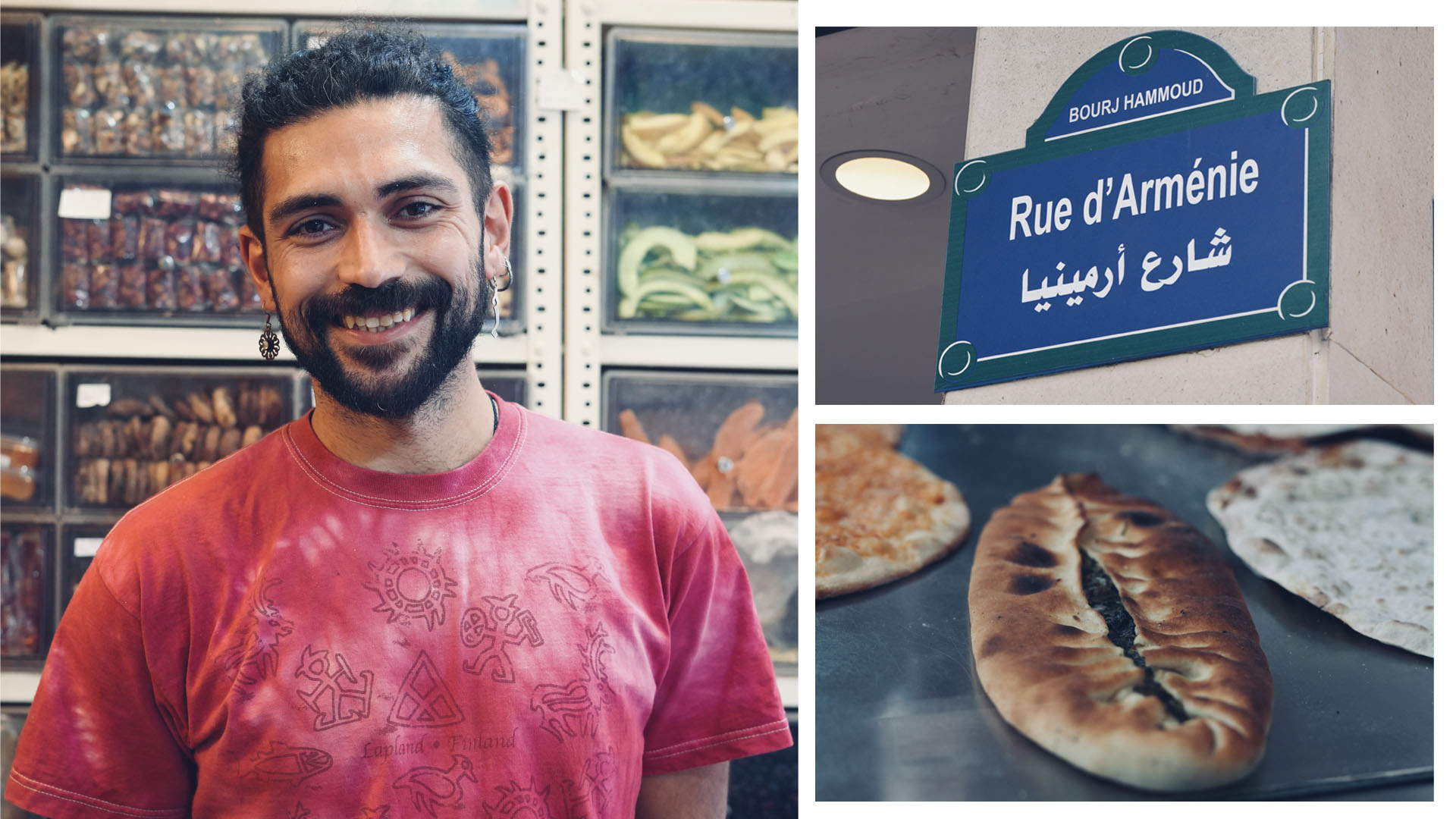 Collage of Yervant who gives food tours of Armenian cuisine in Bourj Hammoud, Beirut, 10 May, 2024 (Photo: Olivia Le Poidevin/L'Orient Today)
Collage of Yervant who gives food tours of Armenian cuisine in Bourj Hammoud, Beirut, 10 May, 2024 (Photo: Olivia Le Poidevin/L'Orient Today)
"I think Armenians here were inspired by the Lebanese debs el remmen [pomegranate molasses] with tahini and decided to mix sugar with tahini to make this cake. I remember when I was young my father used to put sesame oil with sugar. While the culture was being formed sesame oil and sugar was the poor family’s energy booster snack - cheap and nutritious," explains Yervant.
Faith and dessert
Armenian food tradition is driven by its strong Christian faith. In Armenian cuisine there is a dessert for every occasion, says Yervant. Christianity has been present in Armenia since the second half of the first century. Armenian churches, bakeries and restaurants coexist happily in bustling Burj Hammoud. On Saint Sarkis feast day in February, the Armenian community is known to prepare "Sarkis Halva," a marshmallow-like dough stuffed with walnuts and topped with sesame seeds. "When it’s Easter or the holidays you always find these on the table with some wine or cherry liqueur – along with cookies with almonds, cashew, dates."
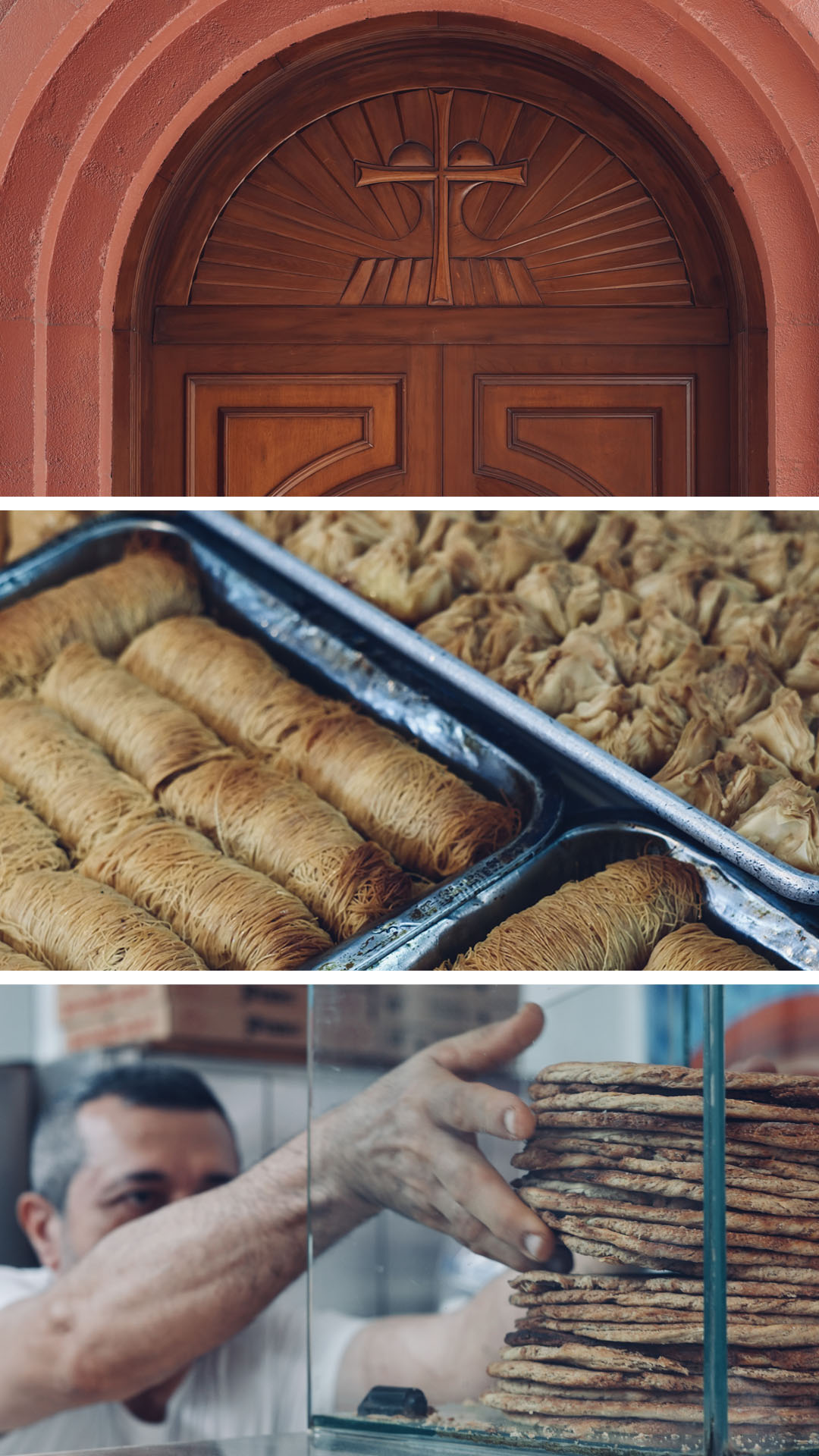 Collage of Saint Vartan church door, Baklava and Tahini bread served at an Armenian bakery in Bourj Hammoud, Beirut, 10 May, 2024 (Photo: Olivia Le Poidevin/L'Orient Today)
Collage of Saint Vartan church door, Baklava and Tahini bread served at an Armenian bakery in Bourj Hammoud, Beirut, 10 May, 2024 (Photo: Olivia Le Poidevin/L'Orient Today)
And one other thing you will find is "Sweet sujuk" (sujuk being the famous spicy bright red Armenian sausage) or "Sharots," a long sausage-like candy containing a string of walnuts dipped into grape syrups, spiced with nutmeg and cinnamon, threaded on string. Like Basterma, (Armenia’s famous dried, fenugreek-cured beef) it is dried for six months. Nicknamed "Armenian Snickers," Sharots has a sweet, fatty, gelatinous texture.
The symbiotic relationship between faith and cooking has been for many, including the three grandmothers, a central support system through the decades of loss and rebirth that have defined the last century for Lebanon's Armenians. During Lebanon’s Civil War (1975-1990), staying inside, cooking and spending time together was the best tonic says Jenni. During this period, the Armenian community halved in size as many fled the country. "When you have food cooking and your family around you, everything is ok," Jeni tells me. And throughout the Covid pandemic, economic collapse and current war, it is once again seated around a table filled with food that the three Armenian grandmothers find the greatest comfort.

